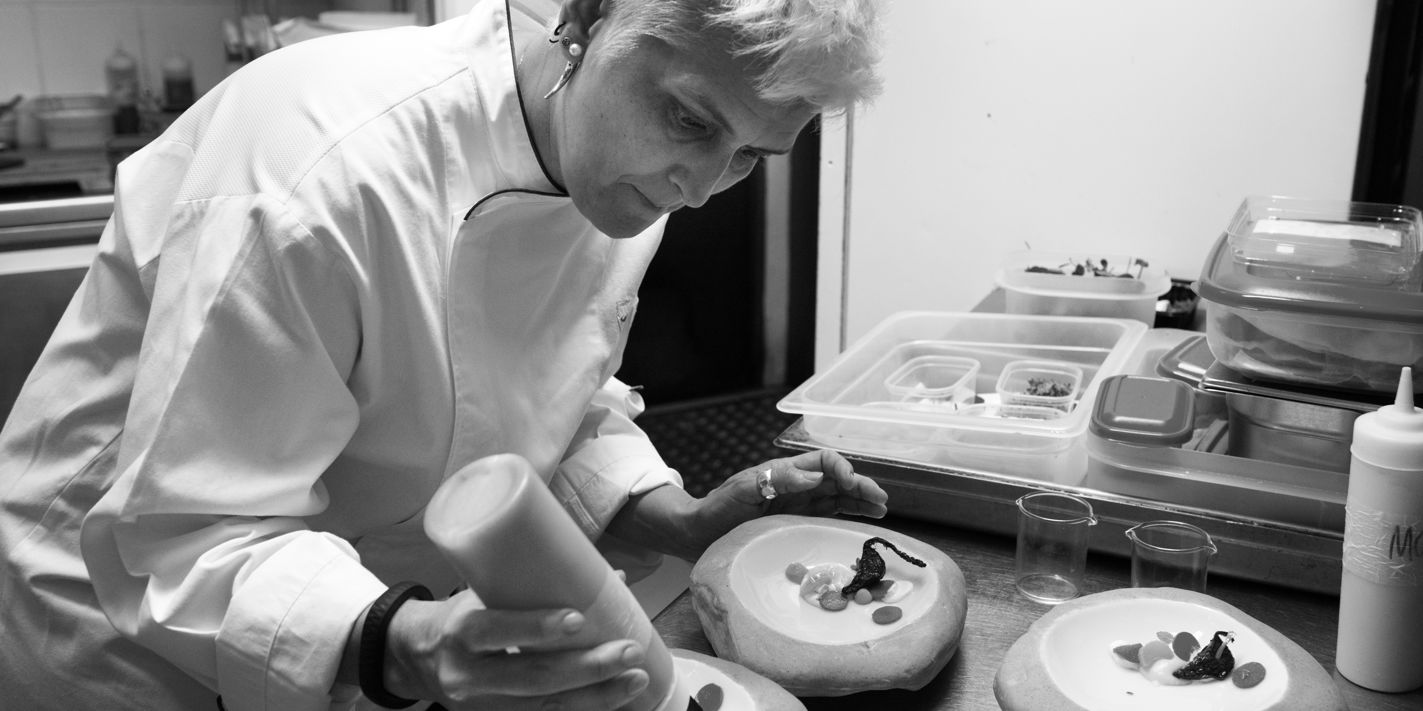Cristina Bowerman

Cristina Bowerman
Cristina Bowerman is a multi-talented chef with a passion for travel and innovative cooking. After many years abroad in the United States, she has returned to Italy, keen on inspiring a new generation of female chefs and leading a fresh, modern era of Italian cooking. Her creative plates are rooted in Italian tradition with international flair.
Born in Cerignola, Puglia, in the south of Italy, Cristina Bowerman grew up in an internationally minded family: ‘I was fortunate in the fact that my family would always travel, as children we would visit many countries. I was open-minded enough to even travel outside my hometown by myself at the age of fourteen.’ She studied foreign languages at school, continuing her academic studies at university where she earned a law degree. A spell working at a law firm followed, before the pull of overseas travel became too much and she left for San Francisco in the United States. She told us: ‘The reason I left Italy was my obsession with America – I went to the U.S.A. to learn more about their society. I just understood them more, I felt I was in the right place.’
The variety of ethnicities she experienced in U.S. cities, as well as their flavourful cuisines, inspired her to pursue a culinary career and after reading about Elena Arzak’s success, realised there was a place for women in the professional kitchen. After completing a course at Le Cordon Bleu College of Culinary Arts in Texas, she secured work in a series of restaurants, finding there several key mentors who have continued to shape her cooking today.
One important influence was Puerto Rican chef Egil Valentin. Cristina Bowerman told us: ‘He introduced me to modern cooking and taught me that tradition must be respected. He was very professional and gave me the right techniques to be strong in the kitchen, not hard working, but effective in the kitchen. I still have a close relationship with him today, he was the most approachable person I’d ever met. Puerto Rican, his food was influenced by his upbringing and gave me greater appreciation of my own traditions. With Egil I learnt a lot about meat, he would cook the most incredible tasting meat. I still use those techniques in my own kitchen today.’ Also in Texas, she worked at the prestigious Driskill Grill with chef David Bull, as experience she describes as ‘the making of me as a professional.’
Another mentor was a woman known as ‘Chef Becky’. She told us: ‘She taught me not to be afraid to be a woman in the kitchen. She would bring in a whole pig, cow or lamb and butcher every part of the meat herself, everything! I knew then that this job could be done by anyone. She taught me how to be smart in the kitchen, moving from one position to the other and doing three things at a time instead of one.’
After fourteen years in the United States she returned to Italy in 2004 to work at Convivio Troiani in Rome, going on to become head chef of two restaurants including the Cuoco a Domicilio, where she partnered up with Andrea Golino. In 2005 she met Fabio Spada and Silvia Sacerdoti, owners of Glass Hostaria, a modern architectural gem in Rome, and soon took over the kitchen. National and international recognition followed, with awards from some the most important culinary guides. In 2008 she received ‘two forks’ in The Gambero Rosso Guide and in 2010 she was awarded a Michelin star – the only female chef to receive one that year. She told us: ‘I returned to Italy and it was a chance series of events that brought me where I am today. But this is only the beginning – it’s taken me ten years to succeed, to get where I am today, but I continue to have no fear. We don’t want riches, we reinvest everything back into the business. Ultimately I want to be a role model for women in the kitchen.’
Although her time in the United States has influenced her style, she has all the ingredients and ideas of an Italian chef driving Italy’s food into the next era. Some dishes remain close to the country’s traditions, such as her Veal and vignarola salad or a delicate dessert of Cassata spheres with ricotta mousse, almond mousse and chocolate, while others show stronger evidence of her time in the United States, such as her Prawn tartare with pico de gallo, hummus and prawn crackers. Some particularly creative plates hint at the breadth of her travels, like this Foie gras sandwich with liquourice and potato chips, mango ketchup and 'passito' mayonnaise or Rack of lamb, Stilton cheese and burnt leek. Reviewing Glass Hostaria, Fodor’s Travel Guide noted her cooking was ‘as innovative as the building she works in … But Bowerman still abides by some cardinal Italian kitchen rules, such as the use of fresh, local, seasonal ingredients.’ In awarding the star, Michelin complimented her ‘excellent cuisine’, with its ‘highly modern touches.’
In 2012, again with Spada and Sacerdoti, she launched Romeo Chef and Baker which houses a bar, restaurant, bakery and delicatessen. Then in 2014, she published her first book, From Cerignola to San Francisco and Back – My Life as a Chef Swimming Against the Tide. Cristina Bowerman’s history and a case study of Glass Hostaria are now taught as Bocconi University, and for several years she has headed cooking courses at several educational establishments, both as professor and course director. Travel remains an important driver for Cristina Bowerman, and she has her sights set on Asia – Japan and Vietnam in particular. She also dreams of opening a restaurant in the United States, but as she says: ‘There is plenty of time to do that!’


